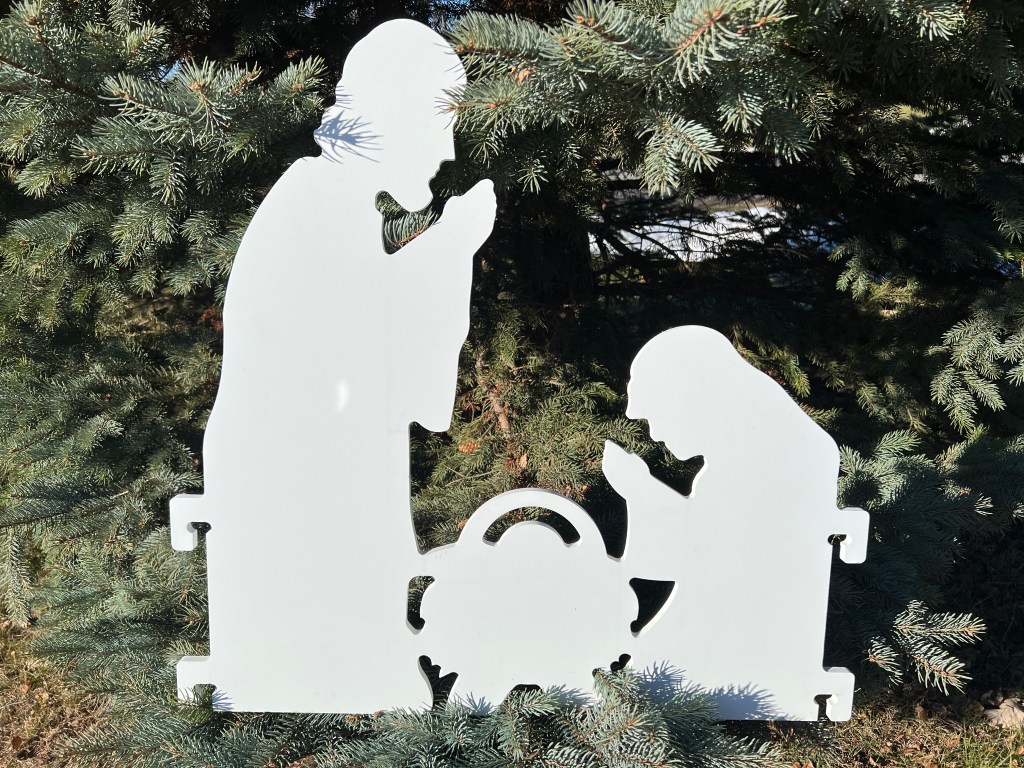
The story of Mary visiting Elizabeth vibrates with energy. There is this back-and-forth, cause and effect, initiative and response. If Newton’s Third Law of physics – that every action has a reaction—were applied to people, here would be a good, positive example.
Mary’s visit causes notable reaction. Her cousin Elizabeth is affected by Mary. And not only Elizabeth. Twice in the description of the visit the Gospel notes that “the child leaped in her womb”.[1] The greeting causes a responsive, palpable joy that we can feel in the text.
The meeting between the yet unborn Jesus and John the Baptist and their mothers is pregnant with meaning – which prompts Mary, then, to sing her famous Magnificat: “My soul magnifies the Lord!” You can’t help but envision this scene which is about relationships between individuals.
Today, I put the final piece in place in the house we have been building for Christ over these past Sundays of Advent. We started with the foundation of love—fences and a frame that made room for everyone including the animals and all creatures great and small. Last week we added the star shining brightly its joyous guidance to those journeying to meet the Lord. Today, we finally see the centrepiece, the Holy Family.
What stands out for me in this particular manger scene is how Mary, Joseph and the baby Jesus in the manger are not separate pieces. They are one piece. Of course, they are one family. They form one unit, connected in their relationships with each other. The emphasis here is their connection rather than their individualities. And I think this is important when we reflect on all things Christian.
The story of Christmas, indeed the story of the bible, is not about autonomous individuals living out their private lives. The emphasis is not as much about individuals as it is about relationship in community: Their relationship with God, and with one another.
Christmas is about people, a cast of characters. If you’d miss anyone in the story it would be incomplete. Missing from this particular manger scene are the Magi and the Shepherds. Perhaps your manger scene at home has these important characters. You can’t tell the Christmas story without the angels, the shepherds, the wise visitors from the East, the animals, the guiding star, Herod, Joseph, Mary and Elizabeth, John the Baptist, Zechariah and of course—at the centre—baby Jesus.
Christmas is about people, and so is Christianity. Christian faith would mean nothing without the cast of characters that make up God’s grand story of faithfulness to the people of God of all time and in every place. Everyone in this story is important, critical, to its telling.
You are a part of God’s story. While faith is personal, faith is not individualistic. When you were baptized, you were not alone baptizing yourself. When you eat the holy meal, you are not doing it all on your own—whether online or onsite here. It’s about the relationships between the individual parts—that’s where the meaning is for faith.
Even our advent wreaths. Whether we have it hanging from the ceiling, or whether it sits on a side table, or shelf, or on a stand in the middle of the floor, the advent wreath is not suspended in a vacuum. Here at Faith, the red ribbons stream upward from the circular frame, four of them, where they are tied securely together at the ceiling. The ribbons hold it all together in place. They are the ‘glue’ keeping the wreath from falling down.
So I have to imagine the shepherds and Magi here as well. They connect prominently to the Christmas story. And what do the shepherds and wise men do when they come to the manger? What comes to my mind is that they kneel, bow, stoop low to get close to see the baby Jesus. Their posture strikes me.
Do your shepherds stand? Do the three Magi remain on their feet or their camels? Or, as they come near to the manger, do they put down their staffs on the ground, and kneel?
Here we probe some depth in the character of God’s relationship with humanity. It’s the posture that’s important, the nature of the relationship. Mary and Elizabeths’ greeting and meeting was one of joy, celebration and praise. What does the manger scene reveal about the nature of our relationship with God, and God’s relationship with us—the glue that holds it all together? What words would you use to describe God’s posture towards us?
It’s the Fourth Sunday of Advent – the last stop on our journey to Bethlehem.
It may be tempting these last days to make it about us, and about our abilities to accomplish everything before the special day arrives. It may be tempting to make Christ’s arrival dependent or conditional on us getting it right. Christmas will happen—we may be tempted to think—only if it happens a certain way (when all the decorations are put out, when the meal is prepared, when all the family arrives, when all the gifts are bought and wrapped, when we can pack a church with robust singing of the favourite carols, etc., etc.).
Martin Luther cautioned people of faith not to depend on our righteousness, our ability, even our humility to make things right with God. So, we can kneel or sit, yes, in all humility. Or, we can stand, if that’s how it is for us. God sees it, and God knows.
But time and time again, what is really important, is that the God of the bible, the God in Christ Jesus, stoops to our level. God initiates the relationship. The first Christmas didn’t happen because people had it all right and organized. God stoops to wherever we are—in our thoughts, our feelings, our actions our beliefs. It doesn’t matter, at the start and at the end, what we believe or don’t believe, what we do or don’t do, what we feel or don’t feel.
God still comes to us. God stoops down to where we are. Christ will come into our world and our lives this COVID Christmas.
And as I’ve said just before the start of the Advent journey this year, I’ll say again at the end:
For, in Jesus Christ, we will meet a God who will not be armed with lightning bolts but will stoop to us with basin and towel.
We will meet a God who will not spew threats and lies but will stoop to the poor with good news for all.
We will meet a God who will not ride a warhorse but stoop on a donkey’s back[2].
We will meet a God not part of the Jerusalem religious establishment, but a God who will stoop to live in backwater Nazareth.
We will meet a God not born in a palace somewhere atop a hill, but a God who will stoop, a helpless, vulnerable baby born to two, poor teenagers in a barn.
Now that our house is built, we can both contemplate the nature of our connections and relationships and pay attention in our words and our deeds to the witness we make to this God who will always stoop, to come to us.
[1] Luke 1:41,44
[2] See “Who’s Coming to Dinner?”, sermon for the Reign of Christ Sunday, November 21, 2021 at http://www.raspberryman.ca



